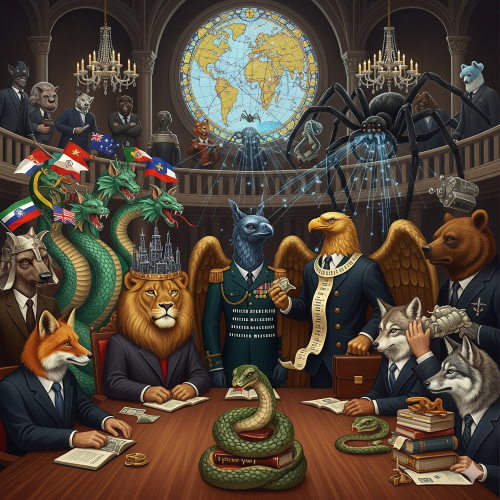How do European elites shape NATO’s partnerships with non-member allies (Australia, Japan, South Korea, etc.)?

European elites actively shape NATO’s partnerships with non-member allies, particularly the Indo-Pacific Four (IP4)—Australia, Japan, South Korea, and New Zealand—by leveraging the Alliance as the primary transatlantic platform for projecting their own security and economic interests into the global arena.
This engagement is driven by a strategy that seeks to manage China's growing influence without escalating military tensions, strengthen the rules-based order which underpins European prosperity, and ensure U.S. commitment to European security through burden-sharing.
The European influence on these partnerships is best understood through a dual strategy where the "Big Four" (France, Germany, Italy, and the UK) have distinct but complementary goals:
1. Expanding the Definition of "Euro-Atlantic Security"
The fundamental way European elites have shaped these partnerships is by successfully expanding NATO’s strategic focus to encompass the Indo-Pacific. This shift was officially enshrined in the 2022 NATO Strategic Concept.
-
The "One Theater" Concept: European leaders, especially since Russia's full-scale invasion of Ukraine, successfully argued that security is no longer strictly regional. They pushed the consensus that developments in the Indo-Pacific—particularly China’s growing assertiveness and North Korea’s support for Russia—"can directly affect Euro-Atlantic security." This narrative justifies the Alliance’s outreach beyond its traditional geographic bounds.
-
The China Challenge: While the U.S. and Eastern European allies primarily view the Indo-Pacific through the lens of hard military deterrence against China, major European powers like Germany and France emphasize the challenge as a "systemic rivalry" (as defined by the EU), focusing on the economic, technological, and hybrid threat dimensions. This approach guides the NATO partnerships towards non-military cooperation in:
-
Resilience and Supply Chains: Collaborating with Japan and South Korea on securing critical supply chains, diversifying away from China, and protecting key infrastructure.
-
Emerging and Disruptive Technologies (EDT): Partnering with the IP4 on co-development and standard-setting for AI, quantum, and cyber defense, areas where these nations are global leaders.
-
2. Strategic and Diplomatic Complementarity
The European approach is characterized by a desire for visible, coordinated action through NATO to reinforce the rules-based order, while simultaneously pursuing bilateral engagement to advance national interests.
| European Power | NATO Partnership Strategy | Core National Interest |
| France 🇫🇷 | The Resident Power: Focuses on operational engagement and maritime security within the NATO framework, leveraging its overseas territories (La Réunion, New Caledonia) to provide a physical, "resident" European presence. This supports its long-standing Indo-Pacific strategy. | Securing its own exclusive economic zones and projecting influence as a global power. |
| Germany 🇩🇪 | The Economic Power: Focuses on political signaling and de-risking through NATO. It has deployed naval assets (like a frigate or air force elements) to the region, symbolically underpinning the NATO commitment to freedom of navigation. | Reducing economic reliance on China while maintaining diplomatic dialogue and upholding global trade norms. |
| United Kingdom 🇬🇧 | The Interoperability Leader: Heavily focused on deepening military and intelligence ties with Australia (via AUKUS) and Japan, often using NATO mechanisms to promote the interoperability of high-end, U.S./UK-aligned defense technology. | Reaffirming its "Global Britain" role and enhancing its position as the premier European security partner for the U.S. |
-
Political Summits: A key achievement of the European and U.S. effort is the regular invitation of the IP4 Heads of State and Government to NATO summits (beginning with the 2022 Madrid Summit). For European elites, this is a visible, high-level diplomatic forum that multilateralizes Western strategy, sending a stronger, unified message to systemic rivals than any single European nation could achieve alone.
3. The Quest for Global Burden-Sharing
European elites utilize the NATO partnership framework to address the long-standing U.S. complaint about "burden-sharing," but with a twist. The goal is to show the U.S. that Europe is pulling its weight, not just in Europe, but also globally, thereby ensuring continued U.S. commitment to NATO's Article 5.
-
Division of Labor: By actively encouraging IP4 partners to contribute to Euro-Atlantic security (e.g., Japanese and South Korean financial and logistical support for Ukraine), European elites argue that they are creating a two-way security street. This frames European engagement in the Indo-Pacific not as a diversion, but as reciprocity designed to free up U.S. resources to address its primary concern—China.
-
Capacity Building: Through the Individually Tailored Partnership Programmes (ITPPs), which guide NATO's bilateral relations with each IP4 nation, European elites prioritize cooperation in areas like military training, cyber defense capacity building, and resilience. This focuses on building the partners' ability to shoulder more responsibility in their own region, which indirectly helps the U.S. pivot more effectively. For example, a partnership with South Korea on cyber resilience strengthens a key U.S. ally and contributes to global stability that benefits European trade.
In summary, European elites initiated and championed the expansion of NATO's global partnerships with the IP4. They shaped the focus to be strategically broad—encompassing economic resilience and technological standards, not just military firepower—in order to align with their own national strengths and commercial priorities. The ultimate aim is to use the collective weight of the Alliance to stabilize the global security environment on which European prosperity depends, without taking on the sole burden of a direct military confrontation in a distant region.
- Questions and Answers
- Opinion
- Motivational and Inspiring Story
- Technology
- Live and Let live
- Focus
- Geopolitics
- Military-Arms/Equipment
- Segurança
- Economy
- Beasts of Nations
- Machine Tools-The “Mother Industry”
- Art
- Causes
- Crafts
- Dance
- Drinks
- Film/Movie
- Fitness
- Food
- Jogos
- Gardening
- Health
- Início
- Literature
- Music
- Networking
- Outro
- Party
- Religion
- Shopping
- Sports
- Theater
- Health and Wellness
- News
- Culture

